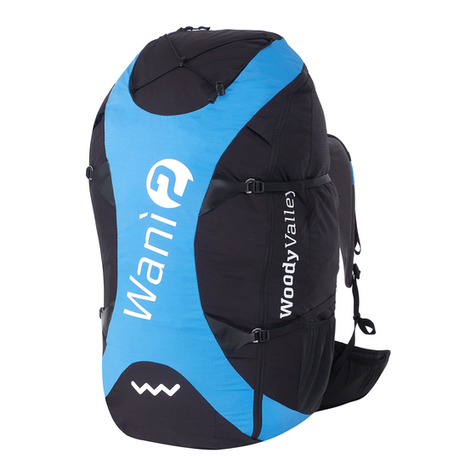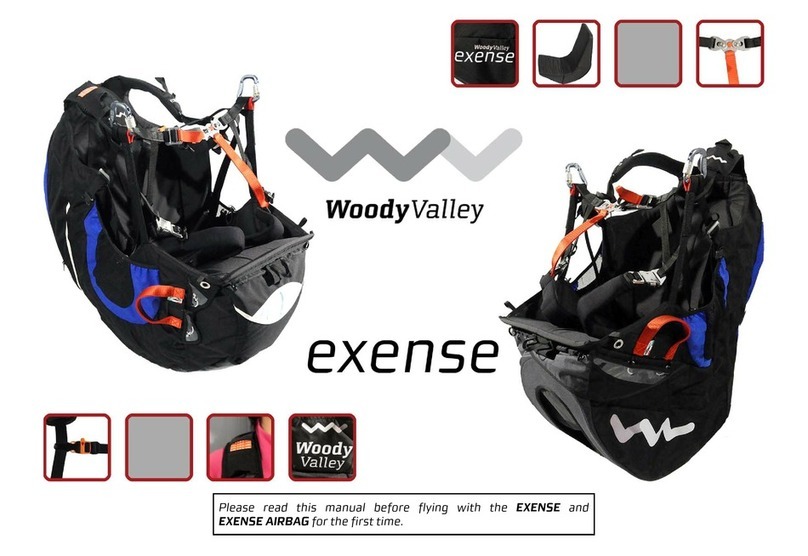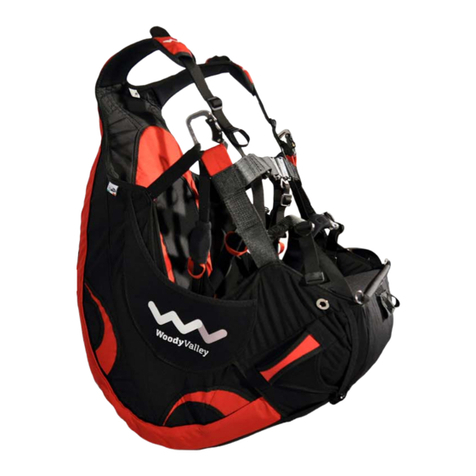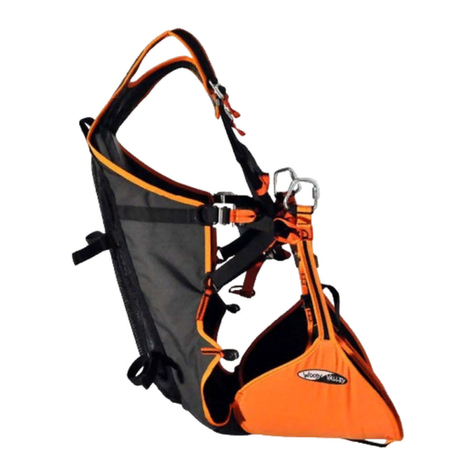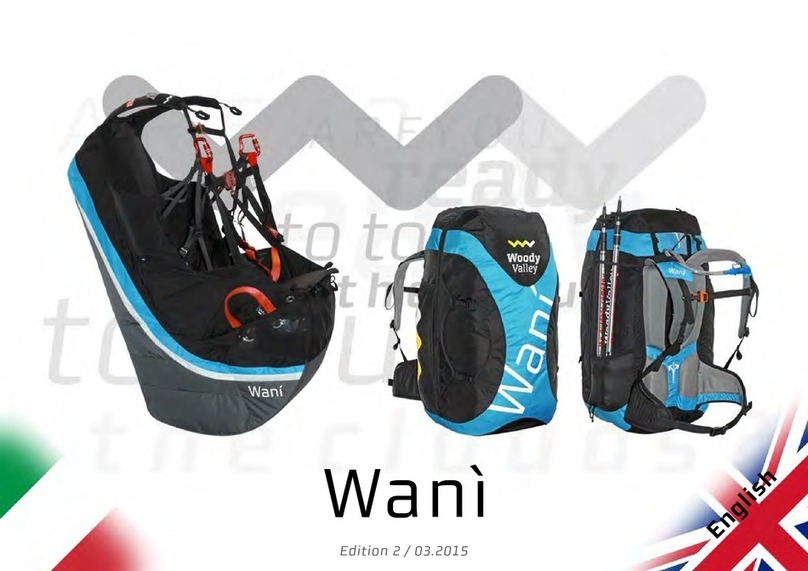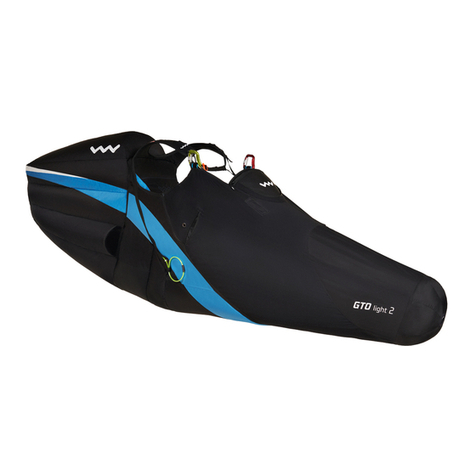
ENGENG
Wanì light 2 - owner’s manual Wanì light 2 - owner’s manual
6 7
1 - GENERAL INFORMATION
This manual is an integral part of the Wanì light 2 harness and should be
stored in a safe place for future reference.
For further information, please contact your reseller or Woody Valley di-
rectly.
Before using the harness, the pilot is advised to read this manual care-
fully.
Declaration of conformity
The manufacturer WOODY VALLEY s.r.l. hereby declares that its pro-
ducts comply with standard UNI EN 1651 - LTF 91-09
This equipment must contain:
- Harness
- Polypropylene seat with flexible front part
- Coupling karabiners
- Dedicated emergency container with attached handle
- 2 reserve elastic loops for closing the reserve parachute
- Speed bar
The main options available are:
- Relax bar
- Quick out Karabiners
1.1- Concept
WANÌ LIGHT 2 is designed to be a complete quality product in the Hike &
Fly category. In just 2.8 kg we successfully
created a full body harness with a high performance thanks to the use
of new construction materials and systems.
The geometry of the strap system has been entirely redesigned to allow
precise but smoother piloting compared to the previous model, so as to
adapt to novice pilots as well as the most experienced, all by adjusting
the length of the chest strap.
The reversibility system remains the same as the wanì light 1, with a
rucksack independent from the airbag enclosed in the rear containment
pocket. This system significantly improves the user experience and the
aesthetics of the two parts because each one was designed for its spe-
cific function. Painstakingly designed in every detail, WANÌ LIGHT 2 pro-
vides the particularity of a conventional harness contained in just 2.8kg.
1.2 - Protection and safety
Like its predecessor, WANì LIGHT 2 uses an airbag that maintains its
shape and, in addition, has a new frontal air inlet that guarantees good
inflation.
Thanks to the use of Nitinol (highly resistant and super elastic metal-
lic wire) inserted in the lower edge of the airbag, we were in any case
able to obtain 60% of the protective capacity before complete inflation
which takes place in flight. The inflation valve has also been comple-
tely redesigned to guarantee airflow in the airbag notwithstanding
the position of the legs. The new valve improves the performance and
aesthetics of the airbag.
The WANÌ LIGHT 2 harness is available only with Get-Up straps which is
the lightest forget-proof safety system for closing sit harnesses.
Harness Impact Pad Report
Inspection certificate number:
PH_286.2019
Manufacturer data: Sample data:
Manufacturer name:
Woody Valley srl
Name impact pad:
n/a
Representative:
Simone Caldana
Impact pad intgrated:
Yes
Street:
Via Vienna 92
Impact pad type:
Airbag
Post code place:
30121 Trento
Serial number:
n/a
Country:
Italy
Weight of sample [kg]:
n/a
Harness model:
Wani Light 2
Summary of Impact pad test
(1)
Max Peak of
Impact [g]
(3)
Duration at 38 [g]
in [ms]
(4)
Duration at 20
[g] in [ms]
(5)
Diff. of test 1
and 2 [%]
(6)
PV
17.37 0.00 0.00 -2.87 POSITIVE
Manufacture Instrument Type no S/N Validity Calibration
Burster/MTS Accelerometer 100 g 89010-100 1263567
JDC elec Geos n°11 Skywatch Geos n°11 22
This declaration must not be reproduced in part without the written permission of AIR TURQUOISE SA.
The validation of this test report is given by the signature of the test manager on the Inspection Certificate no 94.20
Test sample attached to dummy in flying
position, without emergency parachute
Test sample attached to dummy in flying
position, Include emergency parachute
(1)
Calculated value in tests reports include the value minus the uncertainty (on safe side) / The uncertainty stated is the expanded uncertainty obtained by multipl ying the standard
uncertainty by the coverage factor k = 2. The value of the measurand lies within the assigned range of values with a probability of 95%.
(3)
Maximum peak of impact should be less or equal to 50 [g],
(4)
If any, the maximum duration in at 38 [g] should be less or equal to 7 [ms],
(5)
If any, the maximum duration in at 20 [g]
should be less or equal to 25 [ms].
(6)
The test should be done twice, and the 2nd test the maximum peak should not differe more than 20% from the first test, maximum peak.
(2)
The dummy is lifted minimum up to 1.65 m, and impact pad is mounted on. Where the impact occurs, measure distance from bottom of impact pad to ground.
BR | rev 03 | 02.05.2019 Page 1 of 2 ISO 94.22
Inspection certificate number:
PH_286.2019
Name impact pad:
n/a
Test results of Impact pad test
P1 P2 PR1 PR2
Maximum Peak of impact [g]
Impact duration at +38 [g] in [ms]
Impact duration at +20 [g] in [ms]
Difference of test 1 and 2 [%]
100.00 97.13 100.00 103.91
without emergency parachute
include emergency parachute
-5.00
5.00
15.00
25.00
35.00
45.00
10.50 10.70 10.90 11.10 11.30 11.50 11.70 11.90
[g]
Time [s]
P1 20g 38g
-5.00
5.00
15.00
25.00
35.00
45.00
11.50 11.70 11.90 12.10 12.30 12.50 12.70 12.90
[g]
Time [s]
P2 20g 38g
-5.00
5.00
15.00
25.00
35.00
45.00
9.00 9.20 9.40 9.60 9.80 10.00 10.20 10.40
[g]
Time [s]
PR1 20g 38g
-5.00
5.00
15.00
25.00
35.00
45.00
7.50 8.00 8.50 9.00 9.50 10.00
[g]
Time [s]
PR2 20g 38g
RE | rev 01 | 09.03.2018 Page 2 of 2 ISO 94.22
